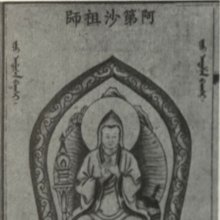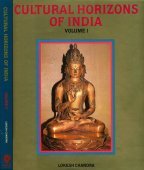Atisha, Atiśa, Atīsa: 8 definitions
Introduction:
Atisha means something in Buddhism, Pali, Hinduism, Sanskrit, the history of ancient India, Hindi. If you want to know the exact meaning, history, etymology or English translation of this term then check out the descriptions on this page. Add your comment or reference to a book if you want to contribute to this summary article.
The Sanskrit term Atiśa can be transliterated into English as Atisa or Atisha, using the IAST transliteration scheme (?).
Images (photo gallery)
In Buddhism
Tibetan Buddhism (Vajrayana or tantric Buddhism)
Source: Google Books: Mahāmudrā and Related InstructionsAtiśa (अतिश) is the name of an ancient teacher belonging to the “lineage of the blessing of practice”, according to “the succession of Gurus in the Mahāmudrā lineages” in the Kagyü School of Tibetan Buddhism (the Mahāmudrā deals with the nature of the mind).—The graduated path of the three levels of beings, which is an adornment [for the Mahāmudrā], is of three lineages: 1. The lineage of vast conduct; 2. The lineage of the profound view; 3. The lineage of the blessing of practice.—[The lineage of vast conduct]—(1) Vajradhara, (2) Tilopa, (3) Nāropa, (4) Ḍombipa, and (5) Atiśa. From Atiśa a union of all three lineages was transmitted successively to (1) Geshé Tönpa [Dromtönpa], (2) Chengawa, (3) Jayülpa, and (4) Gampopa. [...]

Tibetan Buddhism includes schools such as Nyingma, Kadampa, Kagyu and Gelug. Their primary canon of literature is divided in two broad categories: The Kangyur, which consists of Buddha’s words, and the Tengyur, which includes commentaries from various sources. Esotericism and tantra techniques (vajrayāna) are collected indepently.
General definition (in Buddhism)
Source: WikiPedia: BuddhismAtiśa Dīpaṃkara Śrījñāna (980–1054 CE) was a Buddhist teacher from the Pala Empire of Bengal. He was one of the major figures in the spread of 11th-century Mahayana and Vajrayana Buddhism in Asia and inspired Buddhist thought from Tibet to Sumatra. Revered as one of the great figures of classical Buddhism, Atisa was a key figure in the establishment of the Sarma schools of Tibetan Buddhism.
According to Tibetan sources, Atiśa was ordained into the Mahasamghika lineage at the age of twenty-eight by the Abbot Śīlarakṣita and studied almost all Buddhist and non-Buddhist schools of his time, including teachings from Vishnu, Shiva, Tantric Hinduism and other beliefs. He also studied the sixty-four kinds of art, the art of music and the art of logic and accomplished these studies until the age of twenty-two.
Source: Buddhism Tourism: Glossary of Buddhist TermsA Bengali Buddhist Scholar who contributed immensely to the growth of Buddhism in tibet.
Source: academia.edu: The Chronological History of BuddhismAtisa Dipankara Srijnana (321-393 CE) According to Taranatha, Atisa Dipankara Srijnana was the contemporary of Kings Bheyapala? and Nayapala (360-400 CE). He became the head of Odantapuri Vihara and Vikramasila Vihara. He preached Budddhism in Suvarnabhumi (Thailand, Malaysia, Cambodia and Indonesia). He stayed 12 years in Sumatra. He was the key figure in establishment of Tibetan Buddhism. He revived Vajrayana in Tibet.
India history and geography
Source: academia.edu: The Chronological History of Tibetan BuddhismAtisa Dipankara Srijnana (321-393 CE).—According to Taranatha, Atisa Dipankara Srijnana was the contemporary of Pala Kings Bheyapala? and Nayapala (360-400 CE). He became the head of Odantapuri Vihara and Vikramasila Vihara. He preached Budddhism in Suvarnabhumi (Thailand, Malaysia, Cambodia and Indonesia). He stayed 12 years in Sumatra. Atisa was the key figure in establishment of Tibetan Buddhism. He revived Vajrayana in Tibet. According to the Blue Annals, Yeshe-O, the monk king of the Guge kingdom of western Tibet sent his followers to learn and translate some of the Sanskrit Buddhist texts.

The history of India traces the identification of countries, villages, towns and other regions of India, as well as mythology, zoology, royal dynasties, rulers, tribes, local festivities and traditions and regional languages. Ancient India enjoyed religious freedom and encourages the path of Dharma, a concept common to Buddhism, Hinduism, and Jainism.
Languages of India and abroad
Sanskrit dictionary
Source: Cologne Digital Sanskrit Dictionaries: Cappeller Sanskrit-English DictionaryAtiśā (अतिशा).—strike at.
Atiśā is a Sanskrit compound consisting of the terms ati and śā (शा).
Source: Cologne Digital Sanskrit Dictionaries: Monier-Williams Sanskrit-English DictionaryAtīśa (अतीश):—m. Name of a learned Buddhist (the re-founder of Lāmism), [Monier-Williams’ Buddhism 273].
Sanskrit, also spelled संस्कृतम् (saṃskṛtam), is an ancient language of India commonly seen as the grandmother of the Indo-European language family (even English!). Closely allied with Prakrit and Pali, Sanskrit is more exhaustive in both grammar and terms and has the most extensive collection of literature in the world, greatly surpassing its sister-languages Greek and Latin.
Hindi dictionary
Source: DDSA: A practical Hindi-English dictionaryĀtiśa (आतिश) [Also spelled atish]:—(nm) fire; ~[bāja] a fireworks manufacturer; ~[bājī] fireworks; display of fireworks; pyrotechnic.
...
See also (Relevant definitions)
Partial matches: Sha, Ati, Ca.
Starts with (+41): Atisayam, Atisayena, Atishadipamkara, Atishadiya, Atishahana, Atishaitya, Atishakati, Atishakkari, Atishakkaro, Atishakra, Atishakrashobhin, Atishakta, Atishakti, Atishaktibhaj, Atishaktita, Atishakvara, Atishakvari, Atishala, Atishams, Atishamsana.
Ends with: Airavatisha, Apratisha, Bavanavatisha, Kumudvatisha, Milakatisha, Pipatisha, Pratisha, Ratisha, Revatisha, Sapratisha, Taphatisha, Unnatisha, Vimshatisha, Yatisha.
Full-text (+26): Abhisarjana, Kadampa, Aticayokti, Atish, Mrityuvancanopadesha, Jayülpa, Darpa, Geshé tönpa, Chengawa, Dromtönpa, Bodhipathapradipa, Kagyu, Gelug, Ratnakarashanti, Lam rim, Vinayasena, Atishadipamkara, Vairocanabhadra, Aryavimuktisena, Atmasamvedana.
Relevant text
Search found 15 books and stories containing Atisha, Atiśa, Atīsa, Atisa, Atiśā, Ati-sha, Ati-śā, Ati-sa, Atīśa, Ātiśa; (plurals include: Atishas, Atiśas, Atīsas, Atisas, Atiśās, shas, śās, sas, Atīśas, Ātiśas). You can also click to the full overview containing English textual excerpts. Below are direct links for the most relevant articles:
Blue Annals (deb-ther sngon-po) (by George N. Roerich)
Book 5 - The Sovereign Lord (Atiśa)
Chapter 1 - The chapter on the Master (Atīśa) < [Book 5 - The Sovereign Lord (Atiśa)]
Chapter 4a - Untitled responses to questions regarding the Blue Annals < [Book 15 - Monastic Systems]
Formal Education System in Ancient India (by Sushmita Nath)
The Odantapurī university < [Chapter 3 - Centres of Learning in Vedic and Buddhist Period]
The 8th century Vikramaśilā Mahāvihāra < [Chapter 3 - Centres of Learning in Vedic and Buddhist Period]
Bodhisattvacharyavatara (by Andreas Kretschmar)
Text Section 257 < [Khenpo Chöga’s Oral Explanations]
Text Section 210 < [Khenpo Chöga’s Oral Explanations]
Text Section 69 < [Khenpo Chöga’s Oral Explanations]
The Way of the White Clouds (by Anāgarika Lāma Govinda)
Chapter 53 - Final Initiations < [Part 4 - Return to Western Tibet]
Chapter 47 - Critical Days < [Part 4 - Return to Western Tibet]
The gods of northern Buddhism (by Alice Getty)
Tibet (Myth, Religion and History) (by Tsewang Gyalpo Arya)
4. Buddhist renaissance; bsTanpa Phyi dar < [Chapter 7 - Buddhism in Tibet]
1. King Srongtsan Gampo [Tib: Srong btsan sgam po] < [Chapter 4 - King Srongtsan Gampo and His Period]
6. Religious Revival < [Chapter 6 - Tonpa Shenrab Mibo and Bon Religion]
Related products

